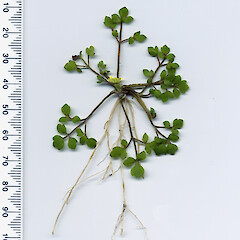Ranunculus ternatifolius
Synonyms
Ranunculus trilobatus Kirk non Kit. ex Schlecht.
Family
Ranunculaceae
Flora category
Vascular – Native
Endemic taxon
Yes
Endemic genus
No
Endemic family
No
Structural class
Herbs - Dicotyledons other than Composites
NVS code
The National Vegetation Survey (NVS) Databank is a physical archive and electronic databank containing records of over 94,000 vegetation survey plots - including data from over 19,000 permanent plots. NVS maintains a standard set of species code abbreviations that correspond to standard scientific plant names from the Ngä Tipu o Aotearoa - New Zealand Plants database.
RANTER
Chromosome number
2n = 32
Current conservation status
The conservation status of all known New Zealand vascular plant taxa at the rank of species and below were reassessed in 2017 using the New Zealand Threat Classification System (NZTCS) – more information about this can be found on the NZTCS website. This report includes a statistical summary and brief notes on changes since 2012 and replaces all previous NZTCS lists for vascular plants.
Please note, threat classifications are often suggested by authors when publications fall between NZTCS assessment periods – an interim threat classification status has not been assessed by the NZTCS panel.
- Conservation status of New Zealand indigenous vascular plants, 2017 . 2018. Peter J. de Lange, Jeremy R. Rolfe, John W. Barkla, Shannel P. Courtney, Paul D. Champion, Leon R. Perrie, Sarah M. Beadel, Kerry A. Ford, Ilse Breitwieser, Ines Schönberger, Rowan Hindmarsh-Walls, Peter B. Heenan and Kate Ladley. Department of Conservation. Source: NZTCS and licensed by DOC for reuse under the Creative Commons Attribution 4.0 International licence.
2017 | Threatened – Nationally Vulnerable | Qualifiers: DP, Sp
Previous conservation statuses
2012 | Threatened – Nationally Vulnerable | Qualifiers: DP, EF, Sp
2009 | At Risk – Naturally Uncommon
2004 | Threatened – Nationally Vulnerable
Distribution
Endemic. North and South Islands. Known from two sites in the North Island (Erua, Makirikiri Tarns). In the South known from NW Nelson, Canterbury, Otago and Southland.
Habitat
Damp sites in forest, scrub and tussock grassland. Often associated with base-rich rocks and substrates.
Wetland plant indicator status rating
Information derived from the revised national wetland plant list prepared to assist councils in delineating and monitoring wetlands (Clarkson et al., 2021 Manaaki Whenua – Landcare Research Contract Report LC3975 for Hawke’s Bay Regional Council). The national plant list categorises plants by the extent to which they are found in wetlands and not ‘drylands’. The indicator status ratings are OBL (obligate wetland), FACW (facultative wetland), FAC (facultative), FACU (facultative upland), and UPL (obligate upland). If you have suggestions for the Wetland Indicator Status Rating, please contact: [Enable JavaScript to view protected content]
FACW: Facultative Wetland
Usually is a hydrophyte but occasionally found in uplands (non-wetlands).
Detailed description
Diminutive, tufted, perennial stoloniferous herb forming diffuse to dense colonies. Leaves (1)-2-ternate, leaflets 91-)2-5(-10) mm diam., long-stalked, entire or ternatifid, sparsely hairy. Flowers leaf-opposed, solitary, 3-4 mm diam., produced from stolons. Pedicels very short, sparsely hairy. Sepals spreading, hairy. Petals 5, yellow, lanceolate or narrow-obovate; nectary single, 1 mm from petal base. covered by small, round scale. receptacle hairy. Achenes (seeds) 5-15(-20), flattened, glabrous, beak curved, 0.5 mm long.
Similar taxa
None
Flowering
October to January (but sporadic flowering may occur throughout the year)
Flower colours
Yellow
Fruiting
November to April
Propagation technique
Very easily grown from fresh seed and division of mature plants. However, plants are difficult to maintain, and are very prone to sudden collapse and are often afflicted with powdery mildew
Threats
Threatened throughout its range by competition from weeds, and habitat loss.
Etymology
ranunculus: From the Latin ‘rana’ frog, meaning little frog and probably refers to the plants typical marshy habit where frogs abound
Where To Buy
Not commercially available.
Attribution
Fact Sheet prepared for NZPCN by P.J. de Lange (1 February 2008). Description based on Webb et al. (1988).
References and further reading
Webb C.J., Sykes W.R., Garnock-Jones P.J. 1988: Flora of New Zealand. Volume IV. Botany Division, DSIR, Christchurch.
NZPCN Fact Sheet citation
Please cite as: de Lange, P.J. (Year at time of access): Ranunculus ternatifolius Fact Sheet (content continuously updated). New Zealand Plant Conservation Network. https://www.nzpcn.org.nz/flora/species/ranunculus-ternatifolius/ (Date website was queried)








